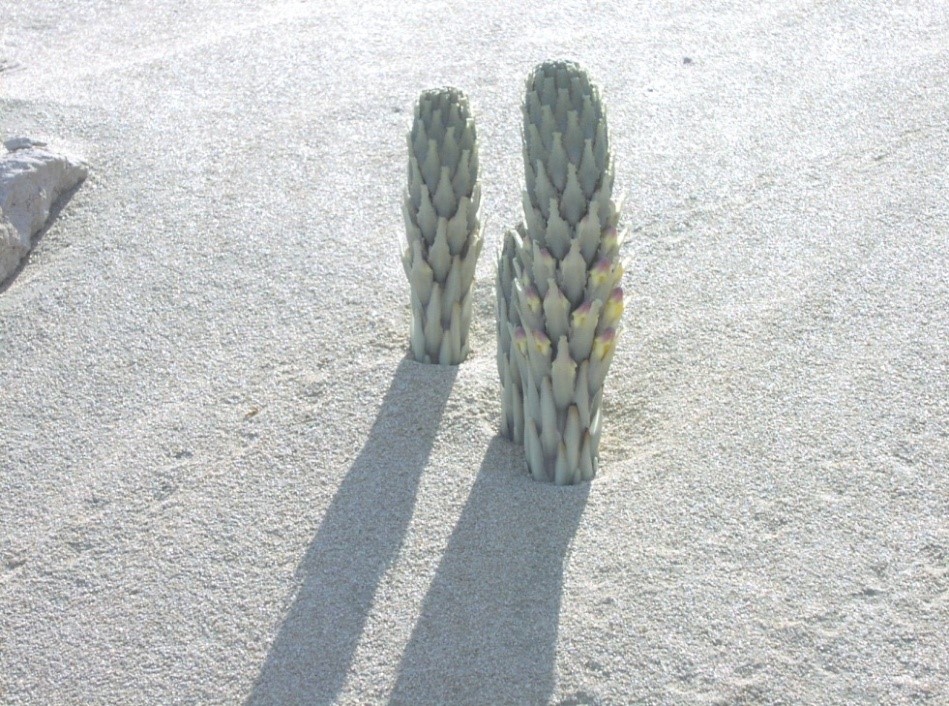
Cistanche tubulosa / طرثوث
Cistanche lutea auct. non Hoffmg. & Link:Wight Cistanche tubulosa var. tomentosa Hook. f. Phelypaea tublosa Schrenk
Danoon, Halook, Terfas, Tarthooth, Zoanoon.
Desert hyacinth
Thanoon, Halook
Scrophulariaceae
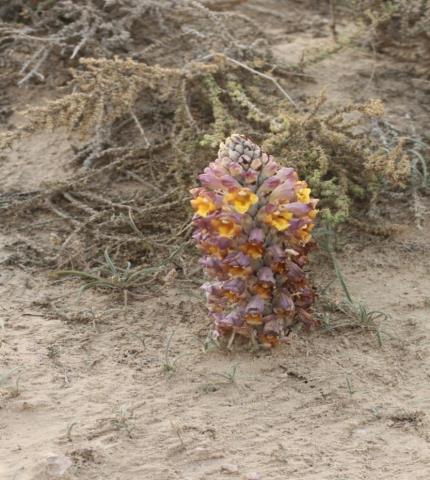
Aerial parts

Herbarium specimen
Ethnobotanical Characteristics
Description
Yellowish to yellow-brown, fleshy herb, 30-60 cm tall, often with a purplish tinge, simple, erect, glabrous to puberulous, often broader (up to 5 cm) at base. Scales 2-3 cm long, 10-15 mm broad, triangular to broadly linear, acute. Bract oblong-lanceolate, often purplish, acuminate, slightly longer than the calyx; bracteoles shorter than the calyx, narrow, linear to sublanceolate. Calyx 14-18 mm long, including lobes c. 1/3 as long as the tube; lobes laterally overlapping, with rounded apex and membranous margins. Corolla 3-5 cm long, 1.5-2 cm broad at the mouth, much narrower and tubular below, usually yellowish with purplish lobes, rarely whitish; lobes short, subrounded, entire, reflexed. Staminal filaments woolly at base; anthers densely hairy, usually rounded or blunt at the ends. Capsules 20-25 mm long, ovoid-oblong, laterally compressed, beaked, many-seeded; seeds 1 mm long, pitted, dark-coloured (Jongbloed 2003, eFloras, Mandaville, 1990).
Habitat and Distribution
Parasite on salt bushes and other plants, widespread on sandy or sandy-salty ground, found throughout the Arabian Peninsula. The plant is common in coastal areas of the Arabian Gulf coast and on inland saline sand plains.
Part(s) Used
Stem
Traditional and Medicinal Uses
The stem is used by traditional medicine practitioners for treatment of diarrhea; the fleshy stem is boiled in water and eaten to treat diarrhea. In North Africa believed to have aphrodisiac properties in North Africa. (Ghazanfar, 1994; Riad Alami, 1975, El-Ghonemy, 1993).
Pharmacognosy and Phytochemistry
Plant material of interest
Dried stem
General appearance
The stem is hard and woody in structure and it has a dark violet to a dark brown colour. It is surrounded by dark violet or dark brown overlapping scales about 2.5 cm long. It has almost a rectangular cross-section with significant ridges and a small ‘hole’ at the center.
Microscopic characteristics
A transverse section of the stem shows from the periphery inwards the following characteristics: The outline of the stem is irregular, and the epidermal layer that consists of anticlinal compactly arranged oblong cells shows some undulations. The cortex consists of many layers of distorted polygonal collenchymatous cells, which are brown, and have thick walls. The vascular bundles consist of groups of phloem and xylem tissues, which are separated by narrow medullary rays; xylem vessels are almost annularly thickened. They have few spirally thickened vessels, and they are all heavily lignified while some of the tracheids are slightly lignified. The pith consists of rounded cells with thick walls and sometimes the cells separate from each other, forming spaces.
Powdered plant material
The stem powder is light brown with a rubber-like odour and a very bitter taste. Microscopically, the powder shows light brown-coloured phloem sieve tubes with oblique slits, dark grey thin compactly packed xylem vessels mostly annularly thickened and groups of shredded brown fibers. There are also occasional light brownish-orange coloured materials.
Parts studied
stem
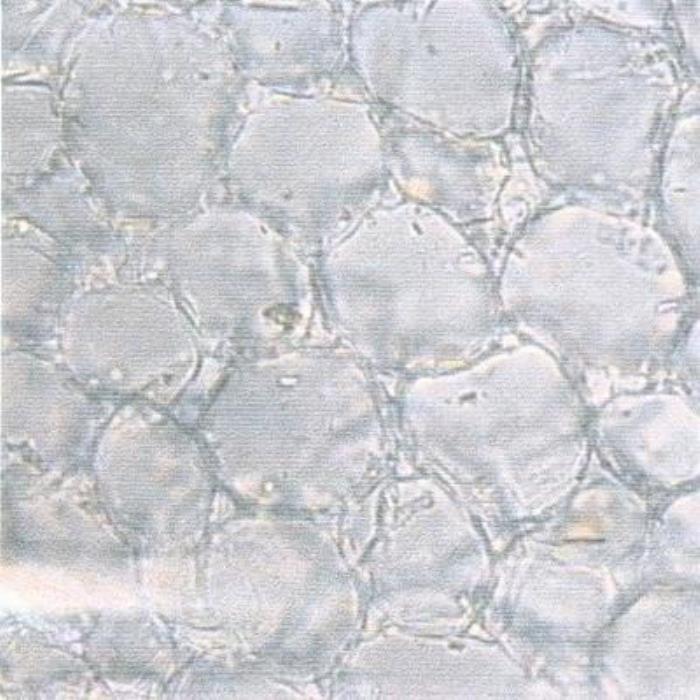
A) Surface view of stem pith
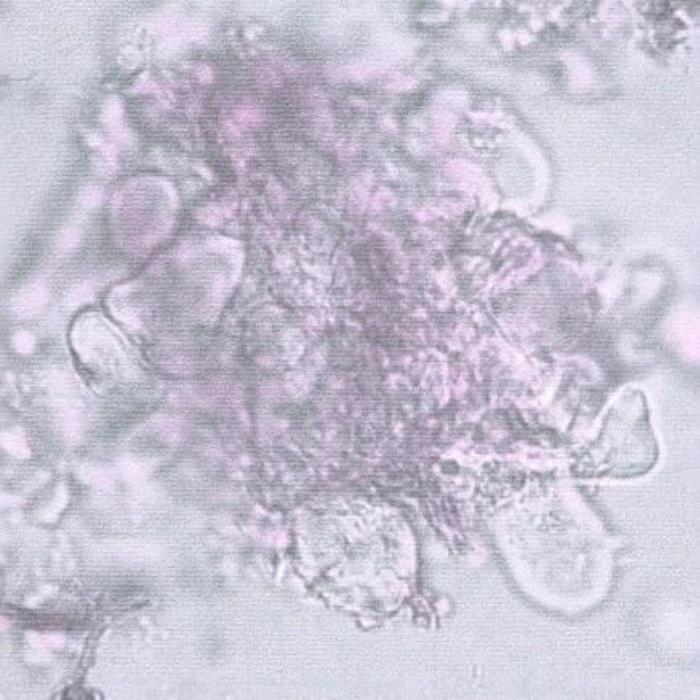
B) TS of stem
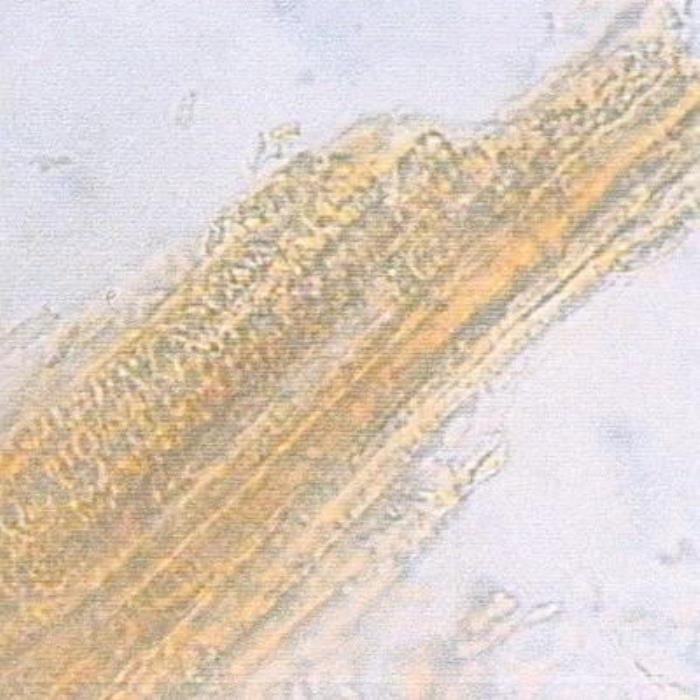
C) Vascular tissues
- A. A surface view of stem pith.
- B. TS of stem. A fragment of tissues associated with whitish separable scaly masses.
- C. A fragment of light brown-coloured adjacent vascular (tissues) vessels mostly annularly and spirally thickened.
Chemical constituents
The stem is rich phenylethanoid glycosides, echinacoside and acteoside (Hai, 2009). The plant contains alkaloids, coumarins, saponins, sterols (and/or terpenes), and tannins (Ghazanfar ,1994). Glycosides: tubulosides A, B, C and D, echinacoside, acteoside, and 2´-acetylacteoside. Phenylethanoid glycoside (tubuloside E) and neolignan glycoside (dehydro diconiferyl alcohol-γ´-О-β-D-glucoside) in the whole plant. In addition, dehydrodiconiferyl alcohol-4-O-β-D-glucoside, syringalide A-3´-α-L-rhamnoside, isosyringalide-3´-α-L-rhamnoside, (+) syringaresinol-O-β-D-glucoside, (+) pinoresinol-O-β-D-glucoside, liriodendrin, 6-dexycatalopol, 8-epiloganic acid, 20-hydroxyecdysone, 8-hydroxygeraniol-1β-D-glucoside and syringing. β-sitosterol, daucosterl, 8-epiloganic acid, echinacoside, castanoside A are present in whole plant (Rastogi, 1993,1998). Phenylethanoid oligoglycoside: kankanosides F and G, and an acylated oligosugar, kankanose in the dried stems of Cistanche tubulosa (Masayuki, 2006).
The following chemical studies have been carried out (Quality Control methods, 1998; Evans, 1996) on the stems of the plant Cistanche tubulosa (ZCHRTM unpublished work):
Physicochemical constants
Loss of weight on drying at 105°C: 13.50
Absolute alcohol solubility: 10.80
Water solubility: 40.00
Successive extractives (%)
Petroleum ether (60-80) °C : 0.70
Chloroform : 1.60
Absolute alcohol : 22.30
Ash values (%)
Total ash : 14.60
Water soluble ash : 9.30
Acid insoluble ash (10% HCl) : 1.00
pH values (aqueous solution)
pH of 1% solution : 6.569
pH of 10% solution : 5.845
Elemental analyses
Ash values (British Herbal Pharmacopeia)
Assay and identification of metal (AOAC International)
|
Apparatus |
AA-6800 Shimadzu-Flame method |
||||
| Element | Std. conc. µg/ml(ppm) | Sample conc. mg/ml | Samples absorbance | Actual conc.mg/ml | Actual conc. (%) |
|
Cr |
1, 2, 4 |
20 |
0.0087 |
0.008515 |
0.0008515 |
|
Zn |
0.25, 0.5, 1 |
20 |
0.6587 |
0.032125 |
0.003212 |
|
Cu |
1, 2, 4 |
20 |
0.0360 |
0.010175 |
0.0010175 |
|
Fe |
1, 2, 4 |
20 |
0.5364 |
0.225785 |
0.0225783 |
|
Pb |
1, 2, 4 |
20 |
0.0018 |
0.002705 |
0.000275 |
|
Cd |
0.25, 0.5, 1 |
20 |
0.0065 |
0.0003 |
0.00003 |
|
K |
1, 2, 4 |
1 |
1.5115 |
13.601 |
1.3601 |
|
Ca |
5, 10, 20 |
1 |
0.0301 |
5. 6467 |
0.56467 |
UV Spectral studies
|
Ultraviolet Spectrum (USP reference) |
||||
|
Apparatus |
Milton Roy Spectronic Genesys 5 Spectrophotometer - Milton Roy. |
|||
|
Sample conc. (mg / ml) |
Solvent |
λmax (nm) |
λ min (nm) |
Abs.( λ max - λ min) |
|
1.015 |
Intestinal Fluid simulated without pancreatic pH=7.50.1 |
325 289 |
265 -ve |
0.969 - 0.775 0.880 |
|
0.99 |
Gastric Fluid simulated without pepsin pH =1.20.1 |
325 |
262 |
0.928 - 0.601 |
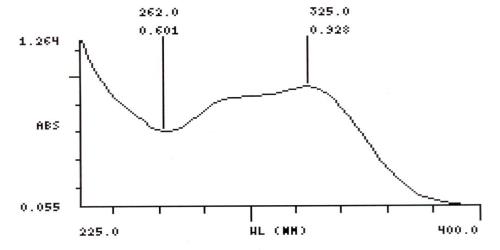
Intestinal Fluid simulated without pancreatic

Gastric Fluid simulated without pepsin
Chromatographic Studies
Thin layer chromatography (Wagner and Bladt, 1996)
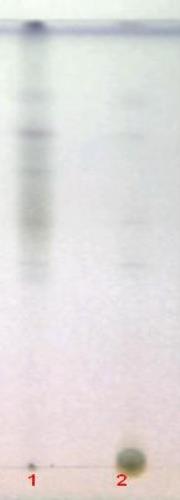
A
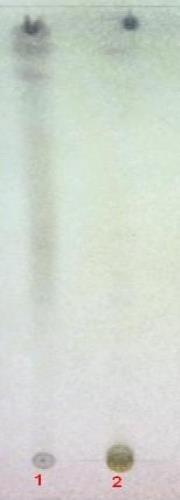
B
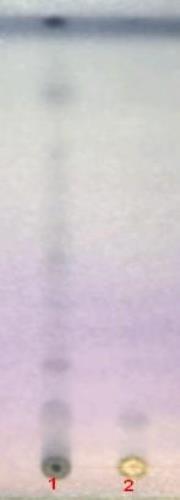
C
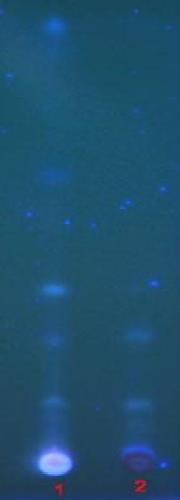
D
TLC fingerprint of Pet. ether (60-80) °C extract (track 1) and MeOH extract (track 2)
|
Mobile phase Fig. |
A |
: |
Toluene, ethyl formate, formic acid (5:4:1) |
|
|
B |
: |
Ethyl acetate, methanol, water (100:13.5:10) |
|
|
C&D |
: |
Toluene, ethyl acetate (93:7) |
|
Detection |
D |
: |
UV 365nm |
|
Derivatization |
A, B&C |
: |
Vanillin-Sulphuric acid-vis |
Pharmacological and toxicological studies
Aqueous extract
Shoots and stems of Cistanche species has been used as a food and tonic in the traditional Chinese medicine for the inefficiency of the kidney. The whole plant of Cistanche tubulosa is used medically in Pakistan as a remedy for diarrhea and sores (Kobayashi, 1987).
The ethanolic extract of Cistanche deserticola showed analgesic and anti-inflammatory effects (Lin , 2002). Cistanche was reported to increase the antioxidative action in vivo significantly and prevent lipo peroxidative damages in tissues (Wang, 1998). A novel monoterpene from Cistanche salsa, a Chinese herb, was reported to be an anti-osteoporotic compound (Yamaguchi, 1999). The phagocytic function of intra-abdominal macrophage in mice was activated by the decoction of C. deserticola and Cistanche tubulosa. It also increased the weight of the seminal vesicle and prostate gland (Zong, 1996).
Four phenylethanoids isolated from the stems of Cistanche deserticola; acteoside (1), 2'-acetylacteoside, isoacteoside, and tubuloside B, significantly suppressed NADPH/CCl4-induced lipid peroxidation in rat liver microsomes (Xiong, 1998).
The methanolic extract from the dried stems of Cistanche tubulosa (Schrenk) R. Wight showed an inhibitory effect on contractions induced by noradrenaline in isolated rat aortic strips indicating vasorelaxant activity (Yoshikawa, 2006).
The attenuation of the serious behavioral disorder and increasing DA (dopamine) levels in the striata of MPTP-lesioned (1-methyl-4-phenyl-1,2,3,6-tetrahydropyridine) in mice was observed reflecting the neuroprotective effects of phenylethanoid glycosides from the Cistanche salsa using Parkinson's disease model in both rodents and primates (Geng, 2004).
Acteoside from Cistanche salsa improved cell viability and prevented the MPP (1-methyl-4-phenylpyridinium ion) induced apoptosis and inhibited the apoptosis-related pathway (Pu, 2003). It is reported that the phenyl ethanoid glycosides of the plant can prevent the 1-methyl-4-phenylpyridinium ion-induced apoptosis in cerebella granule neurons and exert its anti-apoptosis effect by inhibiting caspase-3 and caspase-8 activities (Tian, 2005).
The following pharmacological & safety evaluation studies were carried out on the Aqueous extract of the plant Cistanche tubulosa (Derelanko 2002; Han, 2003):
|
ACTIVITY |
RESULTS |
|||
|
Strong |
Moderate |
Mild |
Negative |
|
|
Analgesic |
|
|
|
√ |
|
Anti-stress |
√ |
|
|
|
|
Anticonvulsant |
|
|
|
√ |
|
Diarrheal |
√ |
|
|
|
|
Effect on rabbit jejunum |
√ |
|
|
|
|
Effect on Guinea pig ileum |
√ |
|
|
|
|
Effect on rat fundus |
|
√ |
|
|
| Effect on right rat atria | √ | |||
|
BP & HR, Carotid artery method |
√ |
|
|
|
|
Effect on Guinea pig tracheal chain |
|
|
√ |
|
|
Hepato-protective |
|
|
|
√ |
|
Utrotropic |
|
|
|
|
|
Biochemical profile |
|
|
|
√ |
|
Motor co-ordination (grip strength & motor activity |
|
|
|
√ |
|
Rectal temperature |
|
|
|
√ |
|
Body weight |
|
|
|
√ |
| Vital organs | √ | |||
Summary of the results
The plant extract administered single dose showed a significant analgesic activity, both, central and peripheral. The extract administered orally showed diarrheal effect. The results revealed the spasmogenic activity of the plant, designates the purgative nature of the plant extract in relieving constipation.

Effect on gastrointestinal motility
The plant extracts showed augmentation of smooth muscles which, may contribute to the laxative effect. However, the overdose may produce gastrointestinal disturbance, stomach upset or diarrhea. The plant extract was also found to increase the percentage of gastric emptying and motility. Thus from this study it appears that the plant extract can serve as a useful alternative to prokinetic drugs. The plant extract showed significant anti-inflammatory and was showed to act as a cardioprotective /myocardial stimulant, along with having a tonic effect on the heart. The plant extract showed a significant reduction of systolic and diastolic blood pressure and heart rate. It also showed anti-stress activity/ Adaptogenic activity and mild anticonvulsant activity. No significant hepatoprotective activity observed.
The single oral dose of the test of the plant did not produce any adverse effect in the general behavior and gross appearance in experimental mice. The drug did not show any sign of salivation, nasal discharge, diarrhea or constipation or loss of righting reflex, lacrimation and tremors in the tested animals. The LD 50 was assumed to be > 6.4 g/kg. The aqueous extract of Cistanche appears to be safe in mice at a dose of 6.4 mg/kg when given orally.
Antimicrobial activity
The aqueous extract of the whole plant was tested against Mycobacterium smegmatis, C. tropicalis, different strains of Methicillin Resistant Staphylococcus aureus, different strains of ESBL-producing K. pneumonia, E. coli, Pseudomonas aeruginosa and showed no inhibition of growth.
References
- Bauer AW, Kirby WMM, Sheriss JC, Turck M. (1966) Antibiotic susceptibility testing by standardized single method. Am J Clin Pathol; 45:493–6.
- British Herbal Pharmacopoeia (1996).4th Ed.: British Herbal Medicine Association (BHMA).
- Derelanko, M. J., & Hollinger, M. A. (2002). Hand book of toxicology. (2nd ed.). Boca Raton, USA: CRC Press.
- El-Ghonemy, A.A. (1993). Encyclopedia of medicinal plants of the United Arab Emirates. (1st ed.). Abu Dhabi, UAE: United Arab Emirates University.
- Evans, W.C (1996).Trease and Evans’ Pharmacognosy,(14th ed,p.105 )Saunders ,London.
- Flora of Pakistan. e-floras, Web.
- Geng X, Song L, PU X, TUP. (2004). Neuroprotective effects of phenylethanoid glycosides from Cistanches salsa against 1-methyl-4-phenyl-1, 2, 3, 6-tetrahydropyridine (MPTP)-induced dopaminergic toxicity in C57 mice. Biol Pharm Bull, 27:797-801.
- Ghazanfar, S. A. (1994). Handbook of Arabian Medicinal Plants. Boca Raton, USA: CRC Press.
- Han , J., & Hoosier, G. L. V. J. (2003). Hand book of laboratory science, animal models. (Second ed., Vol. II). USA: CRC Press.
- Jongbloed, M., Feulner, G., Boer, B., & Western, A. (2003). The comprehensive guide to the wild flowers of the United Arab Emirates. Abu Dhabi, UAE: ERWDA.
- Kobayashi H, Oguchi H, Takizawa N, Miyaze T, Veno A,Usmanghani K, Ahmed M (1987) New phenylethanoid glucosides from Cistanche tubulosa (Schrenk) Hook. F. Part I. Chem Pharm Bull 35:3309–3314
- Lin LW, Hsieh MT, Tsai FH, Wang WH, Wu CR. (2002). Anti-nociceptive and anti-inflammatory activity caused by Cistanche deserticola in rodents. J Ethnopharmacol, 83:177-82.
- Mandaville, J. (1990). Flora of Eastern Saudi Arabia. London, UK.: Kegan Paul International Ltd.
- Masayuki Yoshikawa, Hisashi Matsuda, Toshio Morikawa, Haihui Xie, Seikou Nakamuraa and Osamu Muraoka. (2006). Phenylethanoid oligoglycosides and acylated oligosugars with vasorelaxant activity from Cistanche tubulosa. Bioorganic & Medicinal Chemistry 14 7468–7475.
- Mothana R A A, Abdo SA ,Hasson S, Althawab FM, Alaghbari SA, Lindquist U.( 2008) Antimicrobial, antioxidant and cytotoxic activity and phytochemical screening of some Yemeni medicinal plants. Evid Based Complment Alternat Med. 7(3):323-30.
- Official Methods of Analysis of AOAC International (1999).16th. Ed.Vol.I and II
- Pu X, Song Z, Li Y, Tu P, Li H. (2003). Acteoside from Cistanche salsa inhibits apoptosis by 1-methyl-4-phenylpyridinium ion in cerebellar granule neurons. Planta Med, 69:65-6.
- Quality control methods for medicinal plant materials (1998).World Health Organization, Geneva.
- Rastogi. , & Mehrotra, (1993). Compendium of Indian medicinal plants. (Vol. 4, p187). New Delhi: PID.
- Rastogi. , & Mehrotra, (1998). Compendium of Indian medicinal plants. (Vol. 5, p210). New Delhi: PID.
- Shi,H.M., Wang,J., Wang,M.Y., Tu,P.f., Li,X.B.(2009).Identification of Cistanche Species by Chemical and Inter-simple Sequence Repeat Fingerprinting, Biological and Pharmaceutical Bulletin, 32(1), 142-146
- Tian XF, Pu XP. (2005). Phenylethanoid glycosides from Cistanches salsa inhibit apoptosis induced by 1-methyl-4-phenylpyridinium ion in neurons. J Ethnopharmacol, 97:59-63.
- Wagner, H. Bladt, S.(1996). Plant Drug Analysis-A Thin layer Chromatography Atlas, (2nd Ed.) Springer-Verlag, Berlin Heidelberg.
- Wang X, Li L, Muhuyati , Du N. (1998). Anti-oxidative action of the glycosides of Cistanche in the tissue of mice. Zhongguo Zhong Yao Za Zhi, 23:554-555.
- Xiong Q, Hase K, Tezuka Y, Tani T, Namba T, Kadota S. (1998). Hepatoprotective activity of phenylethanoids from Cistanche deserticola. Planta Med, 64:120-125.
- Yamaguchi K, Shinohara C, Kojima S, Sodeoka M, Tsuji T. (1999). (2E, 6R)-8-hydroxy-2, 6-dimethyl-2-octenoic acid, a novel anti-osteoporotic monoterpene, isolated from Cistanche salsa. Biosci Biotechnol Biochem, 63:731-735.
- Yoshikawa M, Matsuda H, Morikawa T, Xie H, Nakamura S, Muraoka O. (2006). Phenylethanoid oligoglycosides and acylated oligosugars with vasorelaxant activity from Cistanche tubulosa, Bioorg Med Chem. 14:746.
- Yoshikawa,M. Matsuda,H. Morikawa,T., Xie,H., Nakamuraa,S. and Muraoka,O.(2006). Phenylethanoid oligoglycosides and acylated oligosugars with vasorelaxant activity from Cistanche tubulosa.Bioorganic & Medicinal Chemistry, 14: 7468–7475.
- ZCHRTM unpublished work
- Zong G, He W, Wu G, Chen M, Shen X, Shi M. (1996). Comparison between Cistanche deserticola Y. C. Ma and C, tubulosa (Shenk) Wight on some pharmacological actions. Zhongguo Zhong Yao Za Zhi. 21: 436-7.
